
|
1A Grange Rd. Toorak 3141 Australia Ph. 9867 6405 |
|
What is the best way to whiten teeth? The only technique proven to produce obviously whiter teeth is �home bleaching� with professionally constructed mouthguard trays and gel. This approach has been used for decades and it always works. No other technique will give results as good. The trays are made of a very thin transparent plastic and usually cover the ten front teeth. It is important they are designed to fit accurately, not just for comfort, but to prevent the bleach leaking out and being dissolved by saliva. The most common bleaching agent is carbamide peroxide gel, although occasionally its variation, hydrogen peroxide, is substituted. The concentration usually ranges from 10% to 16%. Surprisingly, stronger solutions do not seem to produce whiter smiles or work significantly faster, since they still require time to penetrate the surface.
|
|
Is whitening safe? Home bleaching has been around for many years now and it is an extremely safe procedure, unlike one appointment office beaching which uses strong chemicals and must be performed very carefully (usually for little result.) While there are no long term complications it is very common for people to report transient tooth sensitivity, particularly to cold. It is less likely with the sensible 10% concentration used at our clinic.� This minor hiccup is easily overcome. A number of products can readily desensitise enamel. Colgate Gel Kam is a fluoride concentrate which thickens and blocks the microscopic �organ pipes� tubules that conduct temperature change to the pulp or �nerve�. Recaldent Tooth Mousse (from the clinic) is a dairy extract supersaturated with mineral. It releases calcium and phosphate to likewise occlude the tubules, but to an even greater depth.�� Sensodyne contains potassium nitrate which inhibits sensory transmission in the nerve fibres at the end of the tubules. It virtually acts as an anaesthetic. While it does not make a barrier to the cold, it certainly does help alleviate the feeling. Sensodyne and Tooth Mousse are the most effective products. The best way to apply them is to mix a little together and wear inside the trays for a few nights. See Whitening & Sensitivity. Bleaching does not damage the teeth. In fact being antibacterial and it is sometimes used to prevent decay and gum disease when elderly or handicapped people can not brush properly.
|

|
WHITENING |
|
How long does the whitening take? The timing ranges from two to five weeks, with the average being three. After that any improvements are going to be minor. To be effective the bleaching gel should act on the enamel for about two hours a day. For most people the easiest way is to place a tiny amount in the trays and wear them overnight. (It would be nice if this gave eight hours worth of whitening but the efficacy of the gel drops by half after a couple of hours.) Alternatively, another smart approach is to wear the trays in blocks of thirty minutes, four times a day, when say, driving to work or watching television. This will give a marginally faster result because it ensures that full strength bleach is always interacting with the enamel.��������������������������������������������������������������������������
|
|
Most people see a colour change after just a few days although occasionally it takes a� week or two before an improvement is really apparent.������� |
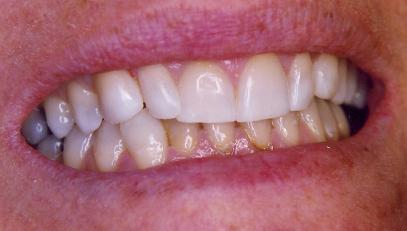
|
How white will the teeth become? Everybody�s teeth have an upper limit as to how white they will end up. When that level is reached, prolonged bleaching will not have any further effect. There is always a significant improvement, sometimes spectacular, although if patients are expecting teeth to look artificial, like bathroom porcelain or liquid paper, they will usually be disappointed. Does it whiten old fillings? The answer is no. There is no effect. This means that if old fillings are to be replaced it might be best to do the bleaching first, so as to determine which colour match to use. Don�t some systems whiten teeth by eight shades? Some businesses promote their systems claiming teeth will whiten 5 shades or 8 levels or whatever. This is meaningless because there is no universal, graded colour chart. It is like Spinal Tap claiming they were the loudest rock group because the dials on their amplifiers did not range up to ten, they went all the way to eleven! What about whitening clinics? It is impossible to really change the colour of teeth in an hour or so, irrespective of fancy lights or lasers. Any difference is an illusion due to teeth drying out. If someone falls asleep with their mouth open, the surface of their enamel dries and the teeth will look whiter for a few minutes until the moisture is reabsorbed. It is basically the same with In Office bleaching. The theory behind lights and lasers is that they hope to accelerate the breakdown of oxygen molecules, from the peroxide, into reactive oxygen atoms which should denature coloured proteins in the tooth surface. Unfortunately the peroxide requires time to penetrate the surface and an hour is insufficient to make any obvious, lasting difference. Professor Van Haywood, the world�s leading authority, recently toured Australia and he reports there is no published evidence of these systems producing any lasting change discernible to the eye. He believes the fancy devices contribute almost nothing to the whitening process and are basically just expensive marketing tools. Is there any way to speed up the whitening? Stronger bleaches lead to more sensitivity but teeth do not respond by whitening more quickly. Lights and lasers can, in theory, stimulate the oxygen but not a great deal can be achieved during a hour appointment. The most practical step is raising the pH slightly, by rubbing a little bicarbonate solution on the teeth before bleaching. Simply� place a teaspoon of baking soda powder in an empty jam jar and add a little water to dissolve. Use a finger to smear some on the front teeth and the surface will become slightly alkaline, so accelerating the action of the bleaching gel. How can I find out more? The world authority is Prof. Van Haywood, who virtually invented whitening twenty odd years ago. Check out his excellent website - www.vanhaywood.com. |
|
But I do not want my teeth to be too white. The whitening is a gradual process, so simply stop when you are satisfied with the colour. How long will the whitening last? This is a slightly contentious issue. In my experience there is no significant relapse although, as people continue to get older, their teeth do continue to darken with age. Of course it is easy to repeat the bleaching for a few days ever year or so. |
|
Check the difference in colour. The upper teeth are mature but they have been whitened, the lowers have not. |
|
CROWNS |
|
Crowns are complete coverings, made up by a dental laboratory after the dentist has drilled and prepared a tooth and then taken an impression. For front teeth they are made of porcelain, often reinforced on the inside with either metal or white zirconia for strength. Crown work is often referred to as Hollywood dentistry, since it is has been the fashion in the movie star set for many decades. When it is done well teeth can look immaculate, although the best crowns also appear completely realistic and imperceptible. Lady Dianna, for instance, had a porcelain crown on a front tooth but it was almost impossible to pick as being artificial. While crowns are wonderful aesthetically, they do suffer a few drawbacks. As well as being somewhat expensive they require a great deal of drilling. Since they are made of porcelain, not rubber, they will not fit around bulges, so teeth need to be shaped into virtual cones. When crowns are being placed on live, healthy teeth there is always the small risk of pulp, or nerve, damage. Responsible dentists think twice before suggesting crowns on vital teeth and always drill as little as possible.
|

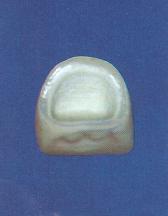
|
One potential complication of the inner metal core is the risk of its grey shadow effecting the crown�s colour. Traditionally technicians have masked any darkness by building up the porcelain in layers, commencing with an opaque white undercoat. Recently they have instead been replacing the metal with white zirconia. This is super strong and, because dark metal does not have to be blocked over, it is easy to achieve excellent aesthetics without sacrificing the crown�s strength and durability. See the Newsletter story Zirconia. |
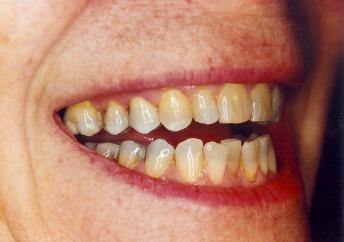
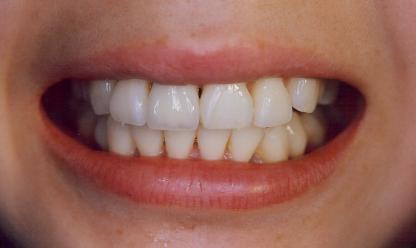
|
CROWN |
|
BEFORE AND AFTERS |
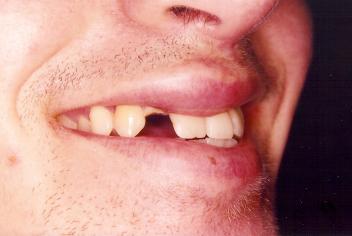
|
Can you pick the new porcelain front tooth? |
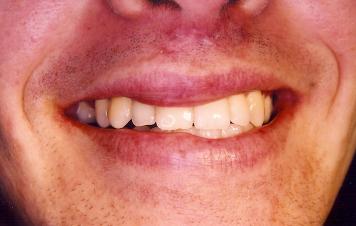

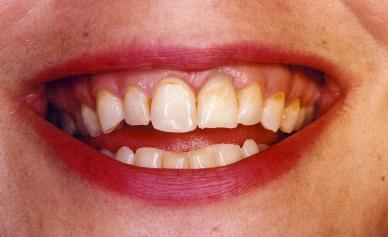
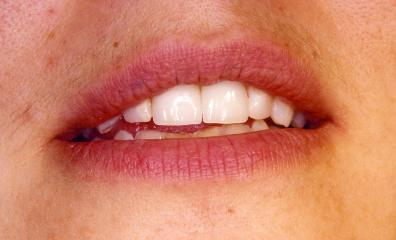

|
VENEERS |
|
Porcelain veneers are like false finger nails; they are thin flakes that are cemented onto the front of teeth to change their colour and shape. If crowns are a traditional means of altering front teeth, veneers are the modern fashion. Once again, they are manufactured as a team effort between the dentist and a laboratory. They can look magnificent. While veneers have outstanding aesthetics, they do have some potential problems. Teeth do need to be drilled slightly - not as much as for crowns, but enough on rare occasions lead to pulp damage. Secondly, they can once in a while fracture. Teeth flex during eating and grinding and the porcelain of a veneer does not bend at the same rate. This mismatch can lead to mechanical stress and subsequent chipping. The porcelain is then very difficult to repair. For some background on how the most expensive veneers can suddenly fail, see the story on Rolling Stone Ronnie Wood. If a person�s bite is heavy and there is a grinding habit, consideration should be given to composite facings instead. These do not require any drilling, are less expensive and can be placed in one visit rather than two. Have a look at some of the Before and Afters in the Cosmetic Bonding section. If this is all a little confusing, do you know what you should do? Have a talk with the dentist and discuss the different options. There is usually more than one way of addressing an issue and it is worthwhile finding out the pros and cons. |
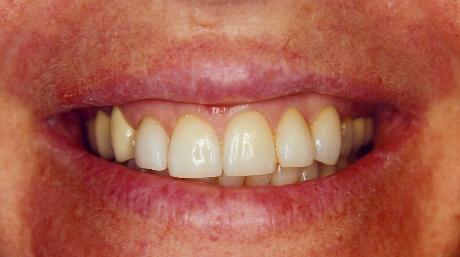
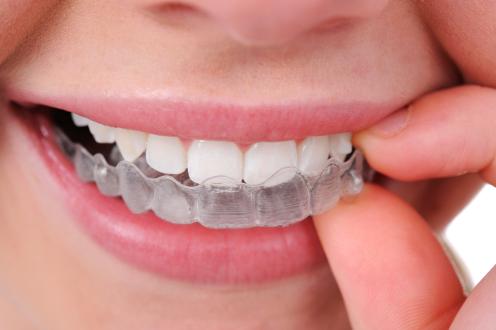
|
Home Bleaching is the safest , most effective way to whiten. It means simply wearing a plastic tray and gel at night for a few weeks. |

|
For back teeth, especially those that have been root filled and are fragile, the great advantage of a crown is its immense strength. Crowns made of porcelain on the outside and metal on the inside are far stronger and more durable than mere fillings. They bind the tooth together and prevent vertical fractures that can sometimes extend under the gums and through the roots. |
|
The four front teeth are porcelain veneers. The best veneers look great, but still like real teeth. |
|
A porcelain crown is a cap, manufactured in a laboratory, which is cemented over a prepared, shaved tooth. |